Posts Tagged ‘Beadhead nymphs’
{{start}}
I am a firm believer that when fishing rivers you have to get down to where the fish are holding and also that flies particularly in faster running water should include “hot spots”. Bead head nymphs are an important part of my ‘trout’ river fly box because they help satisfy both of those criteria. I like to fish them either on the point or first dropper and find that are a great adjunct to a second weighted fly or an unweighted nymph, wee wet or spider.
WIP:
#16 / 2mm copper TBH Droz variant
#16 / 2.5 mm silver TBH Droz variant
#16 / non bead head slightly weighted Droz nymph variant
{{end}}
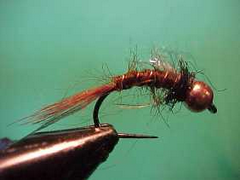
{{+1}}TBH chocolate caddis nymph{{-1}}
{{start}}
Caddis are are common throughout the year but with the greater concentrations occurring from September through to March. They inhabit both running and still water and are a significant food source for most trout often reputed to represent up to 30% of a trout's diet.{{end}}
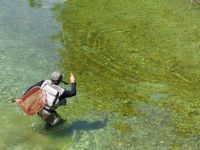
{{+1}}Rivers – French leader / longer leader set up{{-1}}
{{start}}
"French leader" or often called "French Roll Casting" came to my attention in 2009 through the competition sports fly fishing scene. At that stage I was president of Fly Fish Australia and also had the honour on being on one of its international representative teams. This technique was all the buzz and to those that had the opportunity to embrace it the technique was fantastic in the right water.{{end}}
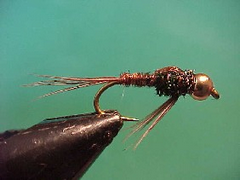
{{+1}}TBH pheasant tail nymph variant{{-1}}
{{start}}
The Pheasant Tail Nymph is a New Zealand pattern designed to suggest a small "Deleatidium Vernal" Mayfly. Whilst that family doesn't extend to Australia I suggest you still carry Pheasant Tail Nymphs or one or two of its variants in a couple of sizes because they are very buggy and particularly useful in faster water.{{end}}
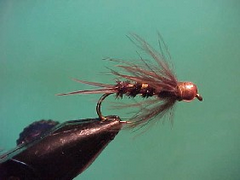
{{+1}}TBH CDC prince nymph{{-1}}
{{start}}
The bead head prince Cul-de-canard (CDC) nymph is a good buggy looking fly that is a variant of the original tie and has a form and function that in an "impressionistic" way incorporates the above shared characteristics. On top of that the CDC wing adds a lot of movement to the fly.{{end}}
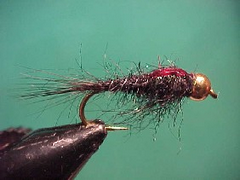
{{+1}}TBH flash back nymph{{-1}}
{{start}}
Flash back nymphs have been around for a long time but they still work. In my view the only trick associated with this fly is to select an appropriate flash material for the flash back. I favour several strands of sparkle flash or similar material rather than a single strand of flat Lurex or tinsel. I tie black, brown and olive versions in a couple of sizes..{{end}}
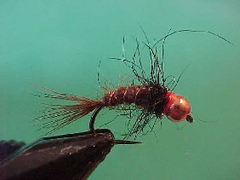
{{+1}}Collared copper mary{{-1}}
{{start}}
I subscribe to a couple of British fly fishing magazines so its not surprising that I have been aware of "Mary" nymphs for quite a while. They are a recurring feature of many of the articles. I had tied and used them on and off for few years but they really didn't come into their own until I became more proficient with short line nymphing and fishing faster rivers.{{end}}
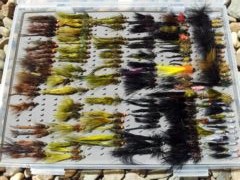
{{+1}}My “trout” fly boxes{{-1}}
{{start}}
The number of fly boxes you carry is obviously one of personal choice. One difficulty you may encounter when you are setting up your fly boxes is which flies you should include, and how many flies you should carry in your fly box or boxes. The last thing you want to be doing is standing on the bank of a river madly pulling flies out to find a fly you know is there . . .somewhere, but it isn't where you expected to find it or you fly box or boxes are so crowded with flies that the one you are desperately looking for is hidden away . . . somewhere.{{end}}
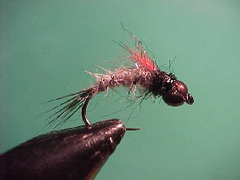
{{+1}}TBH caddis nymphs{{-1}}
{{start}}
This generic representation of a caddis nymph tied on a Czech nymph type hook is one of my favourites. A good buggy looking fly that also has a subtle hot spot emerging wing of UV material. It's such a good fly I carry it in a number of different colour options.{{end}}
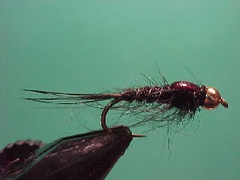
{{+1}}BBH fuzzy nymph{{-1}}
{{start}}
This is the lightest of my bead heads and has its place in both river and still water environments. In rivers they can be fished in the current with as little line drag as possible, can be retrieved at various speeds or can be fished on the drop or through the lift in slower water and pools. In still water that can be fished as an anchor fly in a team or alone. I tie this fly in a couple of sizes in black and olive versions.{{end}}













